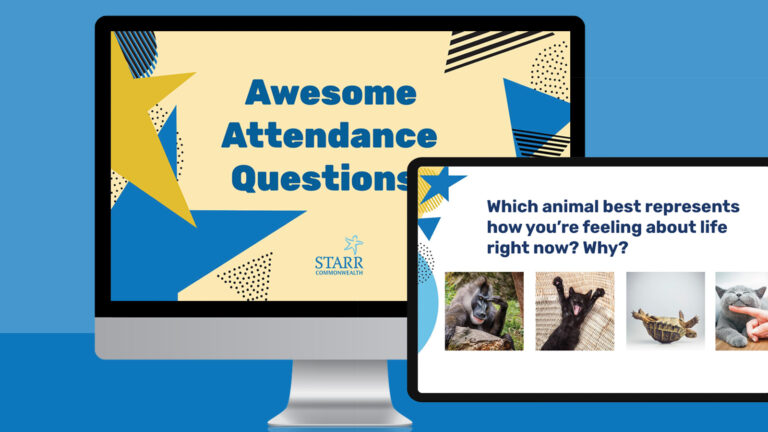For months I received countless Remind texts from students with pictures of waffle fries. I saved a collection of pictures from the Barbie Instagram on my phone. I have purchased (and returned) multiple pairs of shoes.
All because of my most beloved teaching practice: the attendance question.
During online teaching, I began tweeting about my daily attendance questions (or AQs), and it remains one of the topics I’m most frequently tagged in on Twitter, especially this time of year, as teachers seek inspiration and new activities to try.
Although I didn’t create the concept of attendance questions, over time I’ve refined the use of them in my classroom. I’ve come up with inventive ways to keep the questions engaging, unexpected, and best of all, generators of some of the most memorable (and hysterical) conversations we have all year long. If you’re looking for a surefire, completely free, and endlessly entertaining way to get to know and stay connected with your students through the school year, the attendance question is just the tool.
What is an attendance question anyway?
Simply put, the daily attendance question is a low-stakes question for students to answer at the beginning of each class, typically around the time you take attendance. It’s not quite an icebreaker, not exactly a do-now or a warm-up, but more of a conversation starter and a subtle marker that our learning time has begun. Think of it as a soft opening before we begin the “real” work of learning. For secondary students, it fulfills the function of morning meeting in elementary school.
Because of what it’s designed to do, it’s important to implement the AQ routinely. (In fact, in the rare instances I’ve forgotten to post one, the kids become irate and scold me to get my act together.) Very quickly, it becomes a predictable and welcome routine that the kids expect and look forward to each day.
How do you use them?
There’s any number of possible ways teachers can use to introduce the AQ each day. My colleague Paul would have each student verbally share out their response to the AQ as he called their name during attendance. His rationale for that approach was that no matter what, this ensured that each child had spoken aloud and had their voice heard in class each day.
At the beginning of class each day, I post the AQ on the landing page of our learning management system (in my district, we use Schoology; if you were using Google Classroom, for example, the AQ might get posted into the stream). This approach works well for a few different reasons: It allows me to embed visuals that might support the question; it allows students to submit a written response rather than speak up if they’re more reserved; and (this one’s a little sneaky) it helps prepare the kids for the rest of class by ensuring they’ve already got their devices and our class Schoology page open before instruction begins.
Once the question is posted, students type their responses while I take attendance. I’ll read out answers, ask certain students for more detail, or hint at how other classes responded to the same question to encourage competition. I always participate with the students and share my answer as well, but I let them answer first. I joke that if I shared my response first, it might influence theirs, but really it’s so I can see which way the responses lean and decide how to formulate my response to generate further conversation or to maximize controversy and drama.
How to come up with a good attendance question
Both the quality and variety of the attendance question are important to keep kids participating. Some questions are overused (e.g., “Is a hot dog a sandwich?”). Others are too limited or predictable to hold the kids’ interest every day (e.g., “What’s your favorite color?” or “Pizza or tacos?”). I’ve found that mixing up the format of the question, including visuals and options where possible, and finding ways to make the attendance questions feel personally geared to the class all help to keep participation lively.
I come up with most of the AQs I use myself; sometimes I borrow from others or adapt some from social media that translate well to the AQ format. Once you’ve developed a way of curating possible attendance question material, you’ll see that in real life and online, there are endless possibilities for inspiration. Below are some AQs I’ve used in the past, broken into broad categories, and how I find inspiration for new attendance questions each year.
The 3 Types of Attendance Questions (With Examples!)
1. A must: AQs with visual options
I love to give students a collage of images and ask them to tag themselves or choose one of the provided options. This lowers the barrier for participation and takes some of the pressure off of coming up with a unique response. Adding these questions into the mix keeps participation levels high and provides easy opt-ins for all students.
This was last year’s AQ on the first day of school, inspired by a trip to a Florida aquarium: “Tag yourself: Which dolphin are you?” (I was obviously Nefario.)

You can vary your questions for seasons, e.g., “Which jack-o’-lantern are you?”

Or in response to a student remarking the day before that they’d never heard of a Furby: (“You’re a Furby now. Tag yourself.”)

One of the most popular AQs I posted last school year was “Which old-school cell phone should come back?” With a plethora of options to choose from and debate, this style of attendance question can often generate heated discussion, with participants defending their own responses or debating one another’s preferences, and lead to another of my favorite whole-class activities: the Google search-turned-wormhole.

2. AQs based on current trends/topics
Though it’s important to have a collection of evergreen options for those days when you’re feeling less inspired (click here for my list!), sometimes an AQ predicated on a current topic is the discussion-starter you’re looking for. When the Met Gala took place in September 2021, I used the over-the-top costumes to create a “Choose your Met Gala fighter” AQ with celebrities who were recognizable to the students:

Similarly, the (seemingly) innocuous query of “Are there more doors or wheels in the world?” was all over TikTok’s FYP last spring. When I used this question in class, students had pre-generated evidence and assertions all ready to go to back up their positions. For students who may not be aware of these trends, the questions may lack that additional context but are still easily accessible and fun to participate in discussing.
3. The clincher: AQs personally tailored to the class
Crucial to include in the rotation are attendance questions that apply to your own personal context. These questions ensure that the daily practice of the attendance question doesn’t feel like an anonymous activity culled from a pre-generated list of questions: The possibilities of who or what can be the topic of the attendance question are dynamic and ever-evolving. These are the questions that kids remember most and are at the heart of the entire practice: We’re doing this as a way to connect with one another.
In the past, I’ve done this by posting two truths and a lie and having the kids identify the lie (as a bonus, you can ask student volunteers to guest-star and post their own two truths and a lie for their peers to puzzle over). I’ve asked “Which school drill is the best school drill?” and “Why does my arm feel like that?” When the duck that lays her eggs in our school courtyard returned this spring, one AQ asked the kids to guess how many eggs she was hatching. Notably, I’ve invited the students to weigh in on whether I should keep or return fashion purchases made in the middle of the night.


One of my ninth graders this past school year had a habit of taking selfies on my phone anytime I left it out. Once I’d amassed a sizable collection, I asked each class to pick which of his selfies was their favorite.

Not only did he love being the focus of the attendance question, the students got to see a glimpse of what other classes besides theirs are like and the relationships that go beyond the boundaries of a classroom.
More tips on using attendance questions:
- Be mindful to ensure that the attendance question doesn’t seek or demand too much vulnerability. Attendance questions shouldn’t rely on students sharing anything they might consider too personal or sensitive.
- Flip a common question to shake things up. I often flip “What’s your favorite _____?” questions to “What’s your LEAST favorite ______?” Instead of asking students their favorite color, I asked what in their opinion is the ugliest color. Teenagers can be self-conscious sharing favorites or feel put on the spot (how many of us really know our favorite song?).
- Some questions will flop. If a question doesn’t go over well one day, just wrap it up and keep it moving. Don’t place high expectations on every single AQ; some will surprise you with their popularity and others will fall flat. It’s OK!
- Look for possibilities everywhere! The internet has tons of ready-to-use ideas (such as this “Which color is for math?” meme found on Twitter), but take inspiration from your personal life, too. When my best friend from high school shared this picture of her son’s bath toys in an IG story, I borrowed it and used it in classes the next day:

If you’ve just started the school year, it’s not too late to begin the practice of the daily attendance question. Consider your class sizes, ages, and available tools and determine what kind of AQ works best for you. With a little time and consistency, the attendance question will become a beloved fixture of your classroom and a memory your students will carry with them long after their time in your class is over.
Looking for more articles like this? Be sure to subscribe to our newsletters.


